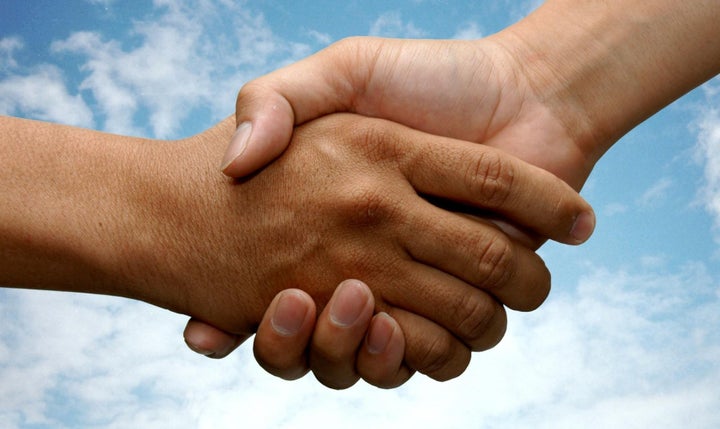Two days after President Trump’s inauguration, I visited the Islamic Society of Baltimore* as part of a Jain-Muslim interfaith exchange. I am Jain myself and several of my closest friends are Muslim. In an effort to stay informed about other religions, I have visited many mosques in the past. I didn’t think this visit would be any different.
But after touring the center, and talking with members of the Baltimore Muslim community, one exchange stuck with me. At the end of the event, an elderly woman from our group (the mother of one of the Jain youth in attendance, who I’ll call Ms. Jain) shared several negative notions she’d held about Muslims for 50+ years. Throughout the tour, our Muslim brothers and sisters not only told us about the history, design, and meaning of the mosque and symbols within it but also answered several questions about the basics of Islam, its core beliefs, and ways in which the Quran has been misinterpreted. Ms. Jain thanked our hosts for sharing openly and clarifying her misconceptions – false beliefs about their dislike of other religions, jihad, and a call to violence. Without skipping a beat or showing even the slightest offense at her blunt tone (as I thought they would have been, or I would have been), our hosts smiled and thanked her. “This is exactly the kind of response we would like and the kind of awareness we need to build. We need more of these exchanges, especially in today’s political climate.”
Five days later, President Trump signed the first executive order on immigration, banning refugees and temporarily banning immigrants from 7 Muslim countries.
--
Since then, it’s been a whirlwind of court actions, threats and open acts of violence against ethnic and religious minorities, and another executive order on immigration. I hear my friends and colleagues itching to “do something” but are unsure what actions to take. I often find myself thinking that, as an individual, I can’t do anything. The problem is beyond the scope of one person.
Thinking that is wrong.
I studied engineering, and one of the first things you learn in any Engineering 101 class is that everything – physical and abstract constructs alike, machine or otherwise – is and can be modelled as a system. A system is made up of sub-components. You can’t fix a machine without changing at least some or all of its parts. Individual and grassroots efforts, like the Jain-Muslim interfaith exchange, play a much more critical role in altering mindsets and our landscape than we think they might. They combat fear and ignorance at its most basic and core levels, building awareness and compassion from the ground up.
Top-down approaches to affect change are important but real systems change occurs when large scale organizational efforts are combined with an emphasis on bottom-up actions and the role of smaller actors and individuals.
--
Everyone holds implicit biases and makes assumptions about people, cultures, or things that do not look like us. Without trying hard we can all probably think of at least three inherent biases our close friends, family members, or relatives hold – whether about Muslims, African Americans, Latinos, women, LGBTs, disabled persons, Asians, or straight, white men.
I grew up in South Carolina, the son of two immigrant South Asian parents, and am no stranger to biases, some relatively harmless and others large and hurtful. I get annoyed when friends make offhand gender remarks about women being soft; irritated when family members make statements in jest about gays being effeminate; and roll my eyes when I see yet another brown guy playing a terrorist, a doctor, or a gas station owner on TV. Growing up, classmates ridiculed me for worshiping cows and riding an elephant to school – neither of which is true or possible in South Carolina. The day after the election, my sister was driving home in Atlanta when a white man, unprovoked, rolled down his window, yelled derogatory remarks at my sister, flicked her off, and sped away.
I see all of these things, yet I’d never hold myself above someone else as being ‘not racist.’ There is no such thing. Biases, stereotypes, and assumptions stem from a lack of awareness and we all have them. As individuals, the least we can do to combat large scale ignorance and discrimination is to challenge ourselves and those around us to get outside of our comfort zone and learn about the other.
As a Jain Indian American – a minority within a minority – it is rare to meet someone who has heard of my religion. People often ask me, “Who’s Jane?” It’s exhausting to always play the role of the informer. While growing up in the Deep South, I had to constantly defend myself from “being saved.” When I finally moved North, I had to defend myself from my South Asian, Ivy League educated Hindu peers (who you might think know better) as they made ill-informed statements about Jainism and told me it’s “really just a sect of Hinduism.” At the same time, I know how extremely heartwarming and humbling it is when someone expresses genuine interest in learning about my faith. Usually, we have little in common otherwise, but I almost always feel an instant connection and shared humanity with their curiosity.
--
We are informed by what we hear on the news, read on the internet, and consume through a self-selected community of mostly similar looking and like-minded individuals. In doing so, we limit ourselves to just one side of multidimensional issues, feed off of each other’s implicit views, and perpetuate misconceptions. Instead, what if we went directly to the communities and cultures we know the least about or fear the most, and we learned about them from them?

In academics, this research method is called ethnography – the study of people in their own environment, on their terms, and by understanding their local context, often through participant observation or face-to-face interviewing. For Ms. Jain, this meant leaving her community, journeying to a new place, and talking to a group of Muslims not just in a transactional way but as equals.
At our core, most of us are looking for a sense of identity and community with those around us. In an increasingly heterogeneous society, it is impossible for that sense of community to come solely from those that look, dress, eat, love, or worship exactly like we do.
So get out there. Be an ethnographer. Seek out what causes you fear and get to know someone beyond the transactional. Don’t just check the box and refuse to let go of prior notions. Approach these conversations from a place of genuine curiosity, not skepticism. Don’t lie to yourself and don't be afraid to admit how little you know. Learning at the source is the best way to dispel false beliefs and build awareness. Much like Ms. Jain, it’s likely that several (and maybe all) of our assumptions will be proven false.
Build bridges, not walls.
*The Islamic Society of Baltimore is famously the mosque that President Obama toured in February 2016 – his first official visit to a U.S. mosque – where he reaffirmed the important role that Muslims play in our nation.
